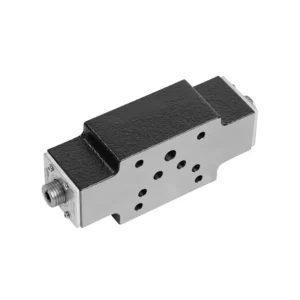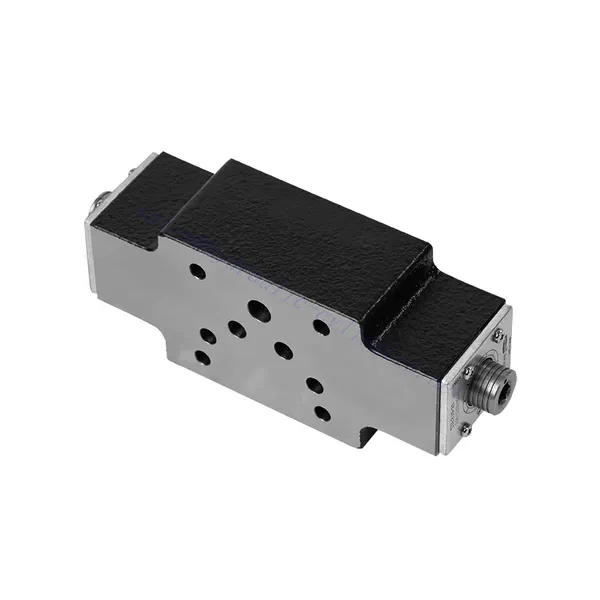Z2FS Series Double Throttle Check Hydraulic Valve
Üheks hüdrosilindrite tootjaks, tarnijaks ja mehaaniliste toodete eksportijaks pakume hüdrosilindreid ja paljusid teisi tooteid.
Palun võtke meiega ühendust üksikasjade saamiseks.
Post:sales@hydraulic-cylinders.net
Tootja tarnija eksportija hüdrosilindrid.
Z2FS Series Double Throttle Check Hydraulic Valve

The Z2FS series double throttle check hydraulic valve is a powerful hydraulic component designed to provide exceptional control and reliability in hydraulic systems. With its unique double throttle check functionality, this valve offers versatility and enhanced performance, allowing operators to optimize their hydraulic applications.
The Z2FS series double throttle check hydraulic valve is an indispensable component for achieving precise control and reliability in hydraulic systems. With its unique double-throttle check design, this valve offers versatility, enhanced control, and system stability. By following the recommended usage methods and maintenance guidelines, operators can ensure the longevity, reliability, and optimal functionality of the Z2FS series double-throttle check hydraulic valve. Upgrade your hydraulic system with this exceptional valve and experience enhanced performance, versatility, and operational efficiency.
Z2FS Series Double Throttle Check Hydraulic Valve Key Characteristics:
- Double Throttle Check Design:
- The Z2FS series valve features a specialized double throttle check design, combining the functionalities of throttle and check valves in one unit.
- This design offers precise flow control and prevents reverse flow, ensuring optimal performance and system efficiency.
- Versatile Application:
- The Z2FS series valve is suitable for various hydraulic systems and applications, including industrial machinery, construction equipment, and agricultural machinery.
- Its versatility allows for seamless integration into various hydraulic setups, providing reliable control and operation.
- Enhanced Control and Stability:
- With its double throttle check functionality, this valve offers precise control over flow rates, enabling operators to optimize the speed and position of hydraulic actuators.
- The valve’s ability to prevent reverse flow enhances system stability and reliability, protecting sensitive components from potential damage.
- Compact and Space-saving Design:
- The Z2FS series valve features a compact and space-saving design, making it ideal for applications with limited installation space.
- Its small footprint allows for flexible installation and easy integration into existing hydraulic systems.
Z2FS Series Double Throttle Check Hydraulic Valve Parameter:
| Specifications | NG6 L4X type | NG6-22 type | ||||||
| Installation position | / | Optional | ||||||
| Flow direction | / | One direction throttle, return through the check valve by another direction | ||||||
| Fluid | Mineral oil suitable for NBR and FKM seal | Mineral oil,Phosphate ester | ||||||
| Phosphate ester for FKM seal | ||||||||
| Fluid temperature range | ℃ | -30 to +80(NBR seals) | -20 to +80 | |||||
| -20 to +80(FKM seals) | ||||||||
| Viscosity range | mm2/s | 10 to 800 | ||||||
| Degree of contamination | Maximum permissible degree of fluid contamination: Class 9. NAS 1638 or 20/18/15, ISO4406 | |||||||
| Nominal flow | bar | 315 | / | |||||
| Max. operating pressure | bar | / | to 350 | |||||
| Max. flow-rate | L/min | 80 | / | |||||
| Size | / | 6 | 10 | 16 | 22 | |||
| Weight | kg | about 1.0 | 0.9 | 3.1 | 4.7 | 8 | ||
Z2FS Series Double Throttle Check Hydraulic Valve Advantages:
NG6 L4X
• Sandwich type structure
• Installation face follow DIN 24340 A and ISO 4401
• Used to restrict the main flow or to control the flow of the two working oil orifices
• Used in inlet or outlet throttle
NG6-22 type
• Sandwich type structure
• Installation face follow DIN 24340 A and ISO 4401
• Used to limit the main port flow or pilot oil flow of two actuator ports
Usage Method Of Z2FS Series Double Throttle Check Hydraulic Valve :
- System Evaluation:
- Begin by assessing the hydraulic system requirements, considering flow rates, pressure differentials, and system specifications.
- Determine if the double throttle check functionality of the Z2FS series valve is necessary for the specific application.
- Valve Selection:
- Select the appropriate variant of the Z2FS series valve based on system parameters and flow control requirements.
- Consider aspects such as maximum flow rate, pressure rating, and compatibility with other system components.
- Installation:
- Follow the manufacturer’s installation instructions carefully, ensuring proper alignment and secure valve connections.
- Pay close attention to flow direction indicators, ensuring correct installation of fittings and seals.
- Flow Control Adjustment:
- Once installed, adjust the throttle control of the valve to achieve the desired flow rate.
- Operators can fine-tune the flow control to match the specific requirements of the hydraulic actuators, optimizing performance and precision.
How Hydraulic Valve Lifters Work?
A hydraulic solenoid valve is an electromechanical device that controls the flow of hydraulic fluid in a system. It operates using the principle of an energized solenoid, which creates a magnetic field to actuate the valve mechanism. Here’s a breakdown of how a hydraulic solenoid valve works:
- Valve Structure:
- A hydraulic solenoid valve typically consists of a valve body, a solenoid coil, a plunger or spool mechanism, and various ports for fluid flow.
- The valve body houses the internal components and fluid passages necessary for controlling the flow.
- The solenoid coil surrounds the plunger or spool and generates a magnetic field when energized.
- Normally Closed (NC) and Normally Open (NO) States:
- Hydraulic solenoid valves can be configured as normally closed (NC) or normally open (NO) based on their resting state.
- In the NC configuration, the valve is closed when de-energized, blocking the fluid flow.
- In the NO configuration, the valve is open when de-energized, allowing fluid flow.
- Valve Actuation:
- When an electrical current is applied to the solenoid coil, it generates a magnetic field.
- This magnetic field attracts the plunger or spool, causing it to move against a spring or pressure differential, depending on the valve design.
- The movement of the plunger or spool opens or closes the valve ports, controlling the flow of hydraulic fluid.
- Electrical Control:
- The solenoid coil of a hydraulic solenoid valve is typically controlled by an electrical circuit, such as a switch or a programmable logic controller (PLC).
- When the circuit is energized, it allows current to flow through the solenoid coil, activating the valve.
- When the circuit is de-energized, the magnetic field dissipates, and the valve returns to its resting state.
- Flow Direction and Pressure:
- Hydraulic solenoid valves have different port configurations to control the direction and pressure of fluid flow.
- Depending on the valve design, there may be inlet ports, outlet ports, and exhaust ports.
- The position of the plunger or spool determines which ports are connected, allowing fluid to flow in specific directions and controlling pressure levels.
- Applications:
- Hydraulic solenoid valves are widely used in various industries and applications where precise control of fluid flow is required.
- They can be found in hydraulic systems for industrial machinery, construction equipment, agricultural machinery, and automotive applications.
- Benefits:
- Hydraulic solenoid valves offer several advantages, including fast response times, precise control, compact size, and ease of integration into hydraulic systems.
- Their electrical control allows for automation and remote operation, enhancing system efficiency and convenience.
Tehase võimekus ja suutlikkus:
(1) Kokkupanek
Meil on esmaklassiline sõltumatu teadus- ja arendustegevuse montaažiplatvorm. Hüdrosilindrite tootmistöökojas on neli poolautomaatset tõstesilindrite koosteliini ja üks automaatne kallutussilindrite koosteliin, mille kavandatud aastane tootmisvõimsus on 1 miljon tükki. Spetsiaalsete silindrite töökoda on varustatud erinevate spetsifikatsioonidega poolautomaatse puhastusmontaažisüsteemiga, mille kavandatud aastane tootmisvõimsus on 200 000 ja mis on varustatud kuulsate CNC-töötlemisseadmete, mehaanilise töötlemise keskuse, suure täpsusega silindrite töötlemise eriseadmete, robotkeevitusmasina, automaatse puhastusmasina, automaatse silindri kokkupanemise masina ja automaatse värvimise tootmisliiniga. Olemasolevad kriitilised seadmed rohkem kui 300 komplekti (komplekti). Seadmete ressursside optimaalne jaotamine ja tõhus kasutamine tagavad toodete täpsusnõuded ja vastavad toodete kvaliteedinõuetele.


(2) Töötlemine
Töödeldav töökoda on varustatud kohandatud kallutatud rööpse treipingi keskuse, mehaanilise keskuse, kiire lihvimismasina, keevitusroboti ja muude seotud seadmetega, mis suudavad töödelda silindritorusid, mille maksimaalne siseläbimõõt on 400 mm ja maksimaalne pikkus on 6 meetrit.

(3) Keevitamine

(4) Värvimine ja katmine
Väikese ja keskmise suurusega silindri automaatse veepõhise värvipinnakattega liinide abil, et saavutada automaatne robotlaadimine ja mahalaadimine ning automaatne pihustamine, projekteerimisvõimsus 4000 tükki vahetuse kohta;
Meil on ka poolautomaatne suurte balloonide värvimise tootmisliin, mis töötab jõukettaga ja mille projekteerimisvõimsus on 60 kasti ühe vahetuse kohta.


(5) Testimine
Meil on esmaklassilised kontrolliseadmed ja katsestendid, et tagada silindri jõudlus vastavus nõuetele.

We are one of the best hydraulic cylinder manufacturers. We can offer comprehensive hydraulic cylinders. We also provide corresponding põllumajanduslikud käigukastid. Oleme eksportinud oma tooteid klientidele üle maailma ja teeninud hea maine tänu meie suurepärasele tootekvaliteedile ja müügijärgsele teenindusele. Me tervitame kliente kodus ja välismaal, et võtta meiega ühendust, et pidada läbirääkimisi äri, vahetada teavet ja teha meiega koostööd!
Tehke ekskursioon meie VR-tehases:
Tehke ekskursioon meie VR-tehases koos järgmisega
Hüdrosilindri kasutamine:


